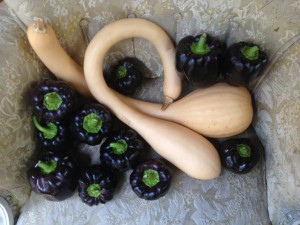I’ve always loved the color purple… the book, the film, and the actual color! It’s the color of eggplants, so beautiful, but what else can be grown and eaten that’s purple?
I love the purple beans I grew this summer, a variety called Royalty Purple Pod Bush Bean. Similar to a regular green bean, they’re eaten whole, pod and all, but are a gorgeous shade of purple on the outside, and a dark green on the inside, about the same shade as a regular French bean.
Tonight I’m serving Purple Majesty potatoes, boiled and then mashed with butter, sea salt and garlic. They’re much healthier than white potatoes, because they have a lower glyceamic index, and simply because of their color.
Anything purple in the vegetable kingdom contains anthocyanins, a group of phytonutrients known to protect humans against cancer and all of the other diseases caused by chronic inflammation of the cells. It makes blueberries blue, it makes blackberries black, and it makes scientists recommend you enjoy a glass of red wine now and then.
What else is purple? Bell peppers can be purple, and carrots can be purple too. And in my gardens, they invariably are… In fact, carrots all used to be purple hundreds of years ago, it’s the orange ones that used to be rare many centuries ago. It’s great that purple carrots are coming back in fashion, they’re much more beautiful, and have all the beta-carotene that orange ones do, plus the anthocyanins. Purple Haze is a good one, also Purple Rain. But my favorite is Deep Purple, not only because it’s the best band name ever, but because it’s the deepest of all the purples…
Also there are some beautiful purple cauliflowers in your local autumnal farmer’s market. My favorite variety is called ‘Di Sicilia Violetto’, and it’s not difficult to grow from seed. It’s a very bright shade of purple, with vibrant green leaves around the crown.
Kale is naturally purple too, and so is purple sprouting broccoli. In fact, LOTS of vegetables are purple, and rightly so… the darker the shade, the better they are for you, and also in my opinion, the better their flavor, and the more enticing they are.
So as well as asking your children to eat their greens, why not eat try giving them purples? They’re so fun and exciting, I have no problem getting kids to eat purple veggies.






